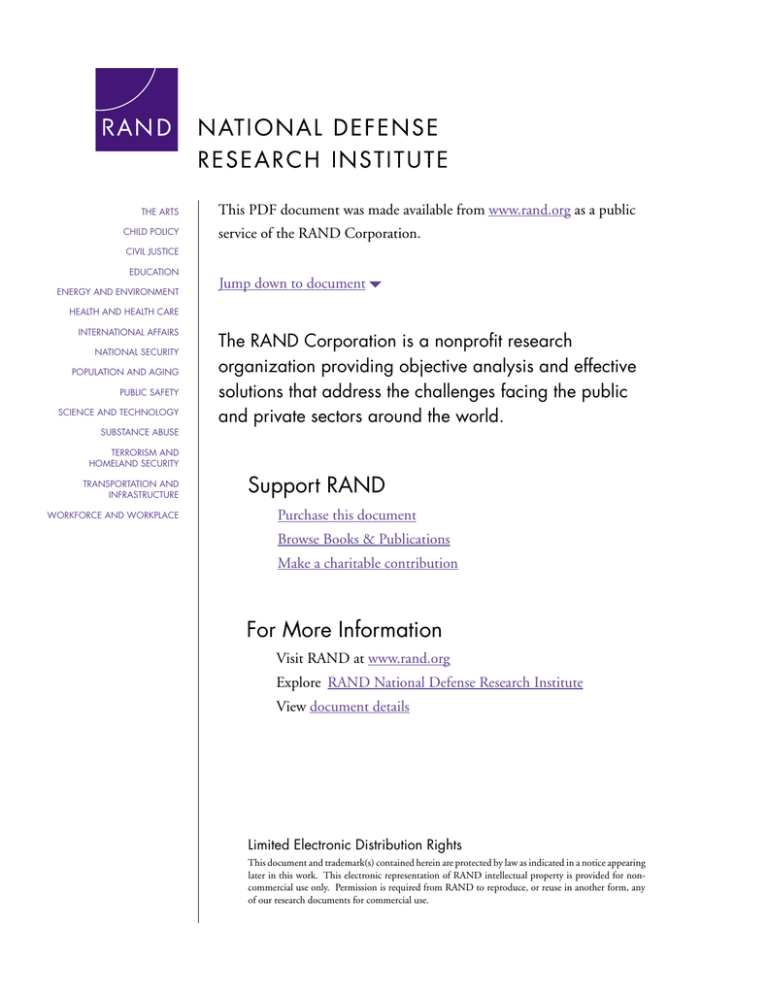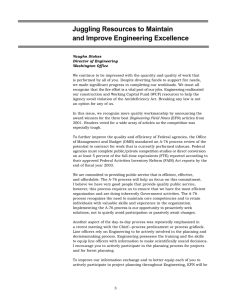
THE ARTS
CHILD POLICY
This PDF document was made available from www.rand.org as a public
service of the RAND Corporation.
CIVIL JUSTICE
EDUCATION
ENERGY AND ENVIRONMENT
Jump down to document6
HEALTH AND HEALTH CARE
INTERNATIONAL AFFAIRS
NATIONAL SECURITY
POPULATION AND AGING
PUBLIC SAFETY
SCIENCE AND TECHNOLOGY
SUBSTANCE ABUSE
The RAND Corporation is a nonprofit research
organization providing objective analysis and effective
solutions that address the challenges facing the public
and private sectors around the world.
TERRORISM AND
HOMELAND SECURITY
TRANSPORTATION AND
INFRASTRUCTURE
WORKFORCE AND WORKPLACE
Support RAND
Purchase this document
Browse Books & Publications
Make a charitable contribution
For More Information
Visit RAND at www.rand.org
Explore RAND National Defense Research Institute
View document details
Limited Electronic Distribution Rights
This document and trademark(s) contained herein are protected by law as indicated in a notice appearing
later in this work. This electronic representation of RAND intellectual property is provided for noncommercial use only. Permission is required from RAND to reproduce, or reuse in another form, any
of our research documents for commercial use.
This product is part of the RAND Corporation documented briefing series. RAND
documented briefings are based on research briefed to a client, sponsor, or targeted audience and provide additional information on a specific topic. Although documented
briefings have been peer reviewed, they are not expected to be comprehensive and may
present preliminary findings.
The Effects of A-76
Cost Comparisons
on DoD Civilian
Education and Training
Edward G. Keating, Dina G. Levy, Joy S. Moini,
Susan M. Gates, Kristin Leuschner, Candice Riley,
Tessa Kaganoff, Catherine H. Augustine
Prepared for the Office of the Secretary of Defense
Approved for public release; distribution unlimited
The research described in this report was prepared for the Office of the Secretary of Defense
(OSD). The research was conducted in the RAND National Defense Research Institute, a
federally funded research and development center sponsored by the Office of the Secretary
of Defense, the Joint Staff, the Unified Combatant Commands, the Department of the
Navy, the Marine Corps, the defense agencies, and the defense Intelligence Community
under Contract DASW01-01-C-0004.
ISBN 0-8330-3632-7
The RAND Corporation is a nonprofit research organization providing objective analysis
and effective solutions that address the challenges facing the public and private sectors
around the world. RAND’s publications do not necessarily reflect the opinions of its
research clients and sponsors.
R® is a registered trademark.
© Copyright 2006 RAND Corporation
All rights reserved. No part of this book may be reproduced in any form by any electronic or
mechanical means (including photocopying, recording, or information storage and retrieval)
without permission in writing from RAND.
Published 2006 by the RAND Corporation
1776 Main Street, P.O. Box 2138, Santa Monica, CA 90407-2138
1200 South Hayes Street, Arlington, VA 22202-5050
201 North Craig Street, Suite 202, Pittsburgh, PA 15213-1516
RAND URL: http://www.rand.org/
To order RAND documents or to obtain additional information, contact
Distribution Services: Telephone: (310) 451-7002;
Fax: (310) 451-6915; Email: order@rand.org
SUMMARY
The President’s Management Agenda, introduced in 2001 (Executive Office
of the President, 2001), calls for increased use of public-private competition
as a strategy for efficiency improvement.
The DoD plans to compete tens of
thousands of positions currently held by federal workers in upcoming years,
following procedures outlined in the Office of Management and Budget’s
Circular A-76 (Executive Office of the President, May 29, 2003).
As the
principal advocate for the quality and cost effectiveness of DoD civilian
education and professional development activities, the DoD Office of the
Chancellor for Education and Professional Development asked the RAND
Corporation to help the office understand the ways in which A-76 cost
comparisons affect DoD civilian education and training.
BACKGROUND
Circular A-76 applies when there is a formal competition between
government employees and contractors.
When a position (or, more likely, a
group of positions) is selected for A-76 competition, a Performance Work
Statement (PWS) is developed that specifies the services the government wishes
to purchase, without specifying exactly how the services are to be provided.
The completed PWS is then transmitted to both government employees and
interested contractors.
Government employees develop an in-house bid, called
the Most Efficient Organization (MEO), which is then compared with the best
contractor bid.
Our research approach combined different methodologies.
A-76 literature, which is discussed in the Appendix.
We studied the
We examined the
Commercial Activity Management Information System data set, which tracks past
A-76 cost comparisons.
We then interviewed participants in completed
competitions, either in person or by phone or email.
We also identified personnel at installations who knew of completed
competitions and their effects.
We asked them about the process, its effects,
and lessons learned for possible future competitions.
In this documented briefing, we examine the effects on civilian education
and training of A-76 competitions across three domains, as depicted in Figure
S.1:
A-76s at DoD-operated educational institutions, education and training
vii
A-76s (i.e., competitions that target education and training functions) at
other installations, and general effects of any A-76 competition on demand for
civilian training.
Any A-76
Education
and Training
A-76s
A-76s at
Educational
Institutions
Figure S.1
Different Domains of A-76 Effects
A-76s AT EDUCATIONAL INSTITUTIONS
We first considered the effects of A-76 cost comparisons on DoD
educational institutions.
We investigated the effects of A-76 competitions on
the Naval Postgraduate School, the Defense Language Institute at the Presidio
of Monterey, and the Air Force Academy.
All three institutions have a primary
focus on military education; all three also have recent experience with A-76.
Broadly speaking, the three institutions’ experiences have been
consistent.
A-76 competitions at all three institutions have targeted support
functions (e.g., public works, personnel support, and logistics).
Consistent
with the findings of other research on A-76, these institutions’ A-76
competitions seem to have generated savings.
Fewer workers (either government
employees or contractors) now provide the studied functions than was the case
prior to the competitions.
However, the A-76 competitions have also raised
viii
concerns.
The competitions have been lengthy and reportedly expensive with
considerable damage to employee morale.
The net effects of A-76 competitions
on the institutions’ education missions are not obvious.
EDUCATION AND TRAINING A-76s
A number of installations and commands that do not have education as
their primary mission have nonetheless conducted A-76 competitions involving
the education and training function.
Many of these competitions have involved
the administrative support of education and training (e.g., scheduling tests,
maintaining records, and counseling personnel).
They generally have not
involved the actual provision of education and training.
(A mix of DoD, other
governmental, and private-sector entities provides education and training to
DoD employees.)
The competitions of this type that we reviewed involved
disparate numbers of authorized positions.
Some of the competitions were won
by contractors, others by government employee MEOs.
Most have saved money but
have resulted in a reduction in customer service, we were told.
GENERAL EFFECTS OF A-76s ON CIVILIAN EDUCATION AND TRAINING
Our research yielded several general findings about the effects of A-76
competitions on civilian training demand.
A-76s may cause a short-run
increase in training demand as DoD employees displaced by competition shift
into different positions.
personnel in MEOs.
Also, civilians may be hired to replace military
On the other hand, long-run training demand may decrease.
If a contractor wins, employee training is usually no longer the DoD’s
responsibility.
Victorious MEOs, meanwhile, are typically smaller than what
they replaced, implying fewer long-run employee training demands.
There also may be different DoD employee leadership training needs with
increased contractor support.
DoD leaders will need to be knowledgeable about
how to interact with contractors.
Further, the tradition of a DoD leader
overseeing personnel in positions the leader once held may become less common.
The development of DoD and other governmental leaders may need to change to
meet future needs.
ix




